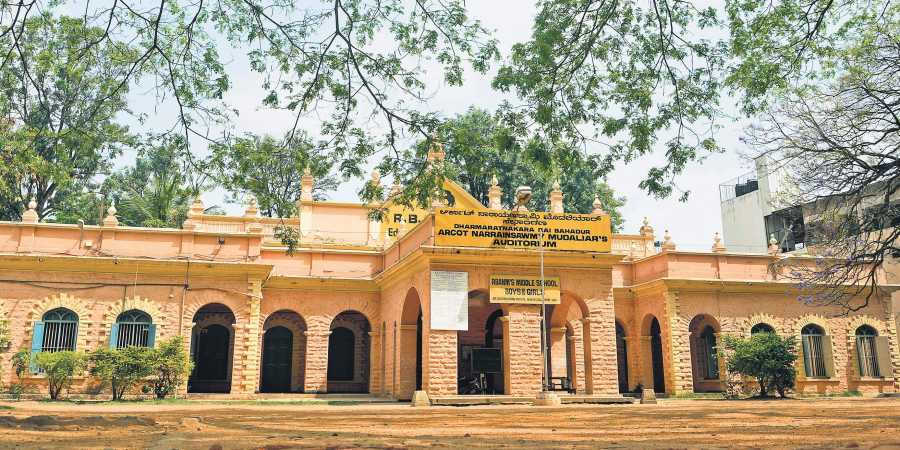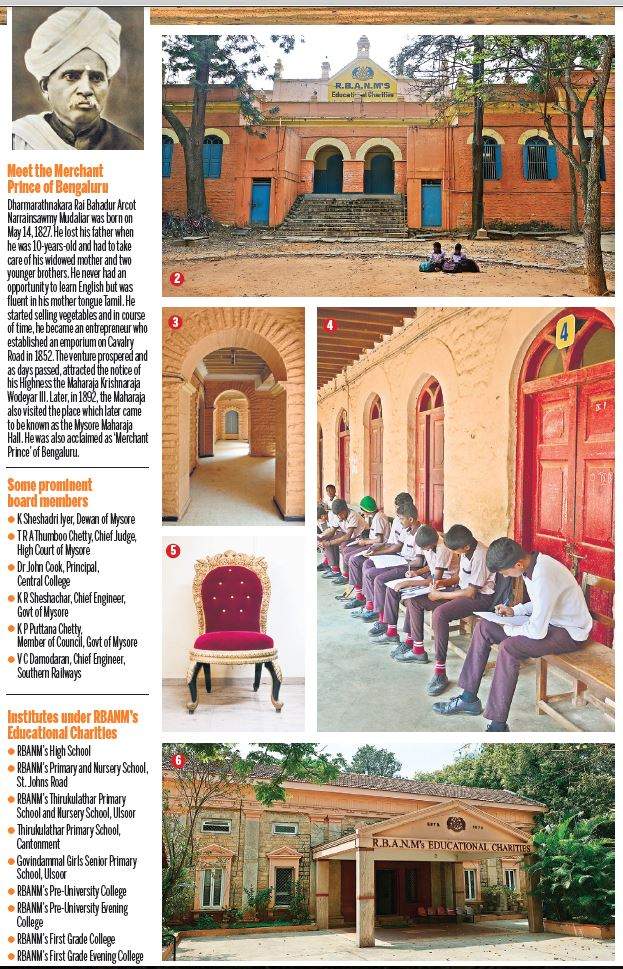RBANM’s Educational Charities is located in a quiet place in Gangadhar Chetty Road and has been running successful educational institutions since it was founded in 1873.
Bengaluru :
RBANM’s Educational Charities is located in a quiet place in Gangadhar Chetty Road and has been running successful educational institutions since it was founded in 1873. The 146-year-old institution, which was founded by Dharmarathnakara Rai Bahadur Arcot Narrainsawmy Mudaliar, runs and manages five schools, two PU colleges and two degree colleges today.
AA Sanjeev Narrain, secretary, RBANM’s Educational Charities, tells CE that the institution provides education from pre-primary to masters level. It was founded by Mudaliar, an entrepreneur who made fortunes by running various businesses. The founder used to supply furniture to the Maharaja of Mysore and set aside one-third of his wealth for the charitable trust when he got a contract for the High Court. “The primary school was set up to cater an English education to the local population. Indians did not have access to an English education. The schools in the Cantonment area catered only to British and Anglo-Indian kids,” Narrain says.
Laying the foundation
According to a collection of records from Dharmarathnakara Rai Bahadur Arcot Narrainsawmy Mudaliar Family History (1827-1998), Origin and Development of Chattram and Other Charities (1872 – 1998) and Educational Charities (1873 – 1998) by Chitra and T V Annaswamy, Mudaliar founded a free English primary school in the cantonment area with an initial endowment of `15,000. Later, it was raised to `40,000 in a rented building on Commercial Street in his deed of settlement dated April 24, 1873, which was approved by JD Gordon, the then Chief Commissioner of Mysore. Since the initial building was not suitable, Mudaliar constructed a stone building in the spacious high grounds of Dickenson Road at a cost of `50,000. During the period, this school was the only one in the Bangalore Cantonment area that was founded by a Hindu citizen that taught students English up to matriculation.
Narrain adds that Bipin Chandra Pal had served as a headmaster at the school for two years. Pal, who was one of the builders of modern India, had come to Bengaluru in August 1881 to take up the post. He had received the offer through Shivanath Shastri, a Sanskrit scholar. However, two years later, a strained relationship with the proprietor led to Pal leaving the institution to return to Kolkata.
Mudaliar was deeply anguished by the wretched conditions of Panchamas, Pariahs, Valangapurathars and Thirukulathars. They lived in separate localities in the cantonment areas and their children were denied admissions in educational institutions that were meant only for people belonging to a higher caste. Mudaliar tried to persuade the government to provide free education to the downtrodden children but all was in vain. He then took matters in his own hands and established Thrukulathar School in 1883 in Bazaar Street, exclusively for students from lower caste communities.At a time when most women were denied a public life, Mudaliar went on to establish the Govindammal Girls School, which is named after his departed wife, in 1886 at Apparao Lane, Ulsoor.
Second technical institute in city
Earlier, technical education was hereditary, where children of craftsmen learned from their fathers and so on. Providing technical education commenced in the state in the late 19th century, thanks to the first technical educational institute, School of Engineering, in Bengaluru in 1860. The second technical institution, Rao Bahadur Arcot Narrainsawmy Mudaliar’s Technical School, was established in 1887 by Mudaliar. Civil engineering was a part of the syllabus and the annual results of the school formed a part of the Annual Administration Report of the Civil and Military Station of Bangalore. The government back then aided the school by absorbing successful students in the State Public Works Department. The institute also attracted students from other places such as Kodagu and Kerala.
In 1888, he then laid the foundation stone for Narrainsawmy Mudaliar’s High School. The establishment was built in an area of 1.5 acres of land at a cost of `60,000. The school has produced several students now in prominent roles. Owing to the want of sufficient space within the compound for physical exercise, a large open ground has been secured on lease from the military and municipal authorities for the use of the school in 1912. MLA Roshan Baig and former CEO and current vice-chairman of Cognizant Technology Solutions Lakshmi Narayanan are also a part of Narrainsawmy Mudaliar’s High School’s alumni.

2) The trust has nine educational establishments under its umbrella
3) The stone building is of the gneiss type
4) The high school has about 600 students
5) The Wellington Chair presented by the British to the ancestors of Narrainsawmy Mudaliar’s family in recognition of services rendered
6) The carriage portico in the South
7) The paved flooring of the school’s corridor
8) Bipin Chandra Pal had served as a headmaster at the school for two years
9) The old structure has been maintained well by the institute
When Bengaluru was hit by the Great Famine in 1876, Mudaliar invested in the Mysore Railway Debentures to gain security for the amount he had already set aside for schools established by him. On October 13, 1981, the debentures were nearing their maturity and Mudaliar requested the government to permit him to deposit an amount of `75,000 with the government at the same interest paid by the debentures. This was done to ensure safety for the endowment and assured annual income for the schools.
Architecture
The stone building is of the gneiss type, which is generally found in and near Bengaluru. While the floor is all paved, the roof has flat terracing throughout and is supported on steel girders and wooden joists in the hall and on wooden beams and joists in other parts. The building has a main entrance with a carriage portico in the South.
source: http://www.newindianexpress.com / The New Indian Express / Home> Cities> Bengaluru / by Akhila Damodaran / Express News Service / March 07th, 2019

